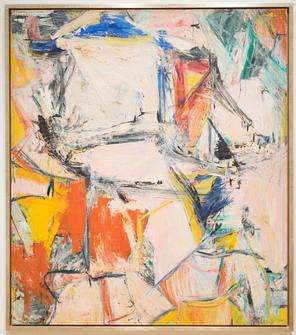Interchange (de Kooning)
Interchange, also known as Interchanged, is an oil on canvas painting by the Dutch-American abstract expressionist painter Willem de Kooning (1904–1997). It measures 200.7 by 175.3 centimetres (79.0 by 69.0 in) and was completed in 1955. It was one of de Kooning's first abstract landscapes, and marked a change in his style under the influence of fellow artist Franz Kline. In September 2015, it was sold by the David Geffen Foundation to Kenneth C. Griffin for $300 million (equivalent to $325,731,065.70 as of 2019), a new mark for highest ever price for a painting, not surpassed until November 2017 by Leonardo Da Vinci's Salvator Mundi.[1][2][3] It has been on loan at the Art Institute of Chicago.[4] [5]
| Interchange | |
|---|---|
 | |
| Artist | Willem de Kooning |
| Year | 1955 |
| Medium | Oil on canvas |
| Dimensions | 200.7 cm × 175.3 cm (79.0 in × 69.0 in) |
| Location | Private collection of Kenneth C. Griffin. Currently loaned to and displayed at the Art Institute of Chicago. |
Background
The completion of the oil painting titled Interchange occurred in 1955 in a decade within which de Kooning had concentrated much of the early part of the 1950s reworking abstract figure study works of the female figure which he started in 1948. These were associated with his solo exhibition in 1953 which was called Paintings on the Theme of the Woman which opened in New York City that year.[6] Some of the titles for these works were associated with various states of Woman I, Woman III and Woman, as well as Two Standing Women. By 1955, de Kooning had moved away from the human form and continued with the abstract rendering of the architecture and communities of his surroundings in downtown New York. The titles of some of de Kooning's 1955 oil paintings prominent at that time were Police Gazette, Composition, Gotham News, Saturday Night, and Easter Monday. During 1956, de Kooning had rendered The Time of Fire in the year after Interchange was completed. As de Kooning stated regarding his penchant for naming his oil works during this period of time, "I feel more at home (in) downtown New York that I would feel ... living on Park Avenue. This has no social comment. It is just that the streets are so goddamn quiet. I mean you can find nothing. Maybe it has something to do with my upbringing, I don't know, but I am in the sight of the average man. I (will) not go up to my studio in a Cadillac."[7] His preferences for the selection of names for his oil paintings appeared to correspond to references to the neighborhood where he was living at that time in downtown New York, for example, Interchange.
Provenance
De Kooning sold the painting shortly after it was completed. It was bought for $4,000 by the architect Edgar Kaufmann Jr., whose father Edgar J. Kaufmann owned Kaufmann's department store in Pittsburgh. Kauffman's estate sold the painting alongside other pieces of his art collection at Sotheby's in New York in November 1989, where it was bought by Japanese art dealer Shigeki Kameyama, owner of the Mountain Tortoise Gallery in Tokyo, for $20.7 million, setting a record price for a living artist (since surpassed). Kameyama claimed his buyer backed out, and he was forced to sell other paintings to pay the hammer price. The work was sold to David Geffen after 1990 at a substantial loss.[8]
In September 2015 Geffen sold Interchange for $300 million to hedge fund billionaire Ken Griffin.[9][10] [11] Griffin paid $500 million for two artworks, the other being Jackson Pollock's Number 17A, to which $200 million was attributed. As of 2017 this is the second highest price paid for a painting, even when inflation is taken into account, almost matched by the sale of Paul Gauguin's When Will You Marry? in February 2015 for close to $300 million, and only surpassed by Leonardo da Vinci’s Salvator Mundi, that sold for $450.3 million in November 2017.
Interchange, along with some other examples of de Kooning's paintings have been sold in the 21st century for near record prices. In November 2006, David Geffen sold his oil painting Woman III to Steven A. Cohen for $137.5 million, just below the record at the time of $140 million, which involved the same people in the same month for Jackson Pollock's No. 5, 1948.[12] A month earlier Cohen had already paid Geffen $63.5 million for Police Gazette by de Kooning.[13]
See also
References
- Smith, Aaron. "Ken Griffin buys two paintings from David Geffen for $500 million". CNNMoney. Retrieved 2016-02-25.
- "Griffin spent $500M on two paintings: Sources". CNBC. Retrieved 2016-02-25.
- "Ken Griffin Spends $500 Million on Two Paintings – artnet News". artnet News. Retrieved 2016-02-25.
- Johnston, Chris (2016-02-18). "Private sale believed to be one of contemporary artwork's largest ever". The Guardian. ISSN 0261-3077. Retrieved 2016-02-25.
- "What is the Most Expensive Painting of Abstract Art Ever Sold? - IdeelArt".
- William de Kooning Paintings. Catalog by Marla Prather. National Gallery of Art, p. 127, Washington. 1994.
- William de Kooning Paintings. Catalog by Marla Prather. National Gallery of Art, p. 134, Washington. 1994.
- Auctions, The New York Times, January 26, 1990
- "Billionaire drops $500M for 2 masterpieces," Feb. 19, 2016, Bloomberg News, as republished by Fox News, at .
- Private sale believed to be one of contemporary artwork's largest ever, The Guardian, 18 February 2016
- Billionaire paid $500 million for abstract expressionist paintings in record art deal, The Daily Telegraph, 23 February 2016
- Carol Vogel, Landmark De Kooning Crowns Collection, The New York Times, November 18, 2006
- Carol Vogel, Works by Johns and de Kooning Sell for $143.5 Million, The New York Times, October 12, 2006